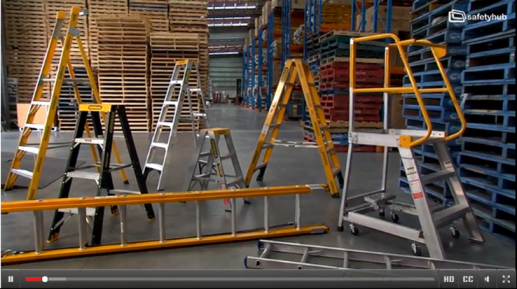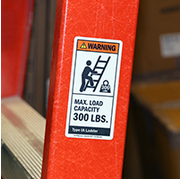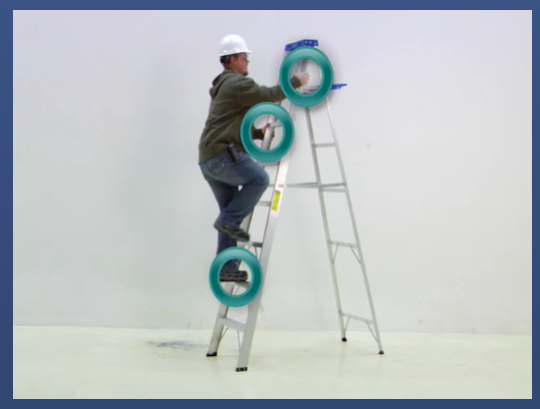The environment of your work site is the first factor in choosing the material from which your ladder is constructed. Ladders are built from one of three basic materials: wood, fiberglass and metal (aluminum). For example, if you are working near sources of electricity, a metal ladder should be rejected since aluminum is an electrical conductor.

Your body can complete an electrical circuit between the electrical power source, the ladder, and then to the ground in the event of a live wire contact incident. An electrical shock while working from a ladder can trigger a fall or cause your heart to stop leading to serious injury or death. On the other hand, if there are no electrical power sources in your work area, the aluminum ladder is the lightest weight when compared to fiberglass or wood.
After checking the environment of the work site, and where the ladder will be setup, the proper ladder length must be selected. It is unsafe to use a ladder that is too long or too short. When using a Step Ladder, for example, standing on the top cap or the step below the top cap is not permitted due to the increased likelihood of losing your balance. Likewise, when using an Extension Ladder, the top three rungs are not to be used for climbing. Safety standards require a label on the ladder to indicate the highest standing level.

Image of the many different types and sizes of ladders – Safetyhub.
Next, consider the Duty Rating of the ladder. This is an indication of the maximum weight capacity the ladder can safely carry. To figure out the total amount of weight your ladder will be supporting, add your weight plus all tools, supplies, and other objects placed upon the ladder.
There are five categories of ladder Duty Ratings:
- Type IAA (Extra Heavy Duty) capacity 375 pounds
- Type IA (Extra Heavy Duty) capacity 300 pounds
- Type I (Heavy Duty) capacity 250 pounds
- Type II (Medium Duty) capacity 225 pounds
- Type III (Light Duty) capacity 200 pounds

Basic Ladder Safety
Ladders are tools. Many of the basic safety rules that apply to most tools also apply to the safe use of a ladder:
- If you feel tired or dizzy, or are prone to losing your balance, stay off the ladder.
- Do not use ladders in high winds or storms.
- Wear clean slip-resistant shoes. Shoes with leather soles are not appropriate for ladder use since they are not considered sufficiently slip resistant.
- Before using a ladder, inspect it to confirm it is in good working condition.
- Ladders with loose or missing parts must be rejected. Rickety ladders that sway or lean to the side must be rejected.
- The ladder you select must be the right size for the job.
- The Duty Rating of the ladder must be greater than the total weight of the climber, tools, supplies, and other objects placed upon the ladder. The length of the ladder must be sufficient so that the climber does not have to stand on the top rung or step.
- When the ladder is set-up for use, it must be placed on firm level ground and without any type of slippery condition present at either the base or top support points.
- Only one person at a time is permitted on a ladder unless the ladder is specifically designed for more than one climber (such as a Trestle Ladder).
- Ladders must not be placed in front of closed doors that can open toward the ladder. The door must be blocked open, locked, or guarded.
- Read the safety information labels on the ladder.
- The on-product safety information is specific to the particular type of ladder on which it appears. The climber is not considered qualified or adequately trained to use the ladder until familiar with this information.

At all times utilize Three Points-of-Contact
When climbing a ladder, it is safest to utilize Three Points-of-Contact because it minimizes the chances of slipping and falling from the ladder. At all times during ascent, descent, and working, the climber must face the ladder and have two hands and one foot, or two feet and one hand in contact with the ladder steps, rungs and/or side rails.

Although the user’s weight or size typically does not increase the likelihood of a fall, improper climbing posture creates user clumsiness and may cause falls. Reduce your chances of falling during the climb by:
- wearing slip-resistant shoes with heavy soles to prevent foot fatigue;
- cleaning the soles of shoes to maximize traction;
- not carrying objects in either hand that can interfere with a firm grip on the ladder, use towlines, a tool belt or an assistant to convey materials
- climbing slowly and deliberately while avoiding sudden movements;
- never attempting to move a ladder while standing on it;
- keeping the center of your belt buckle (stomach) between the ladder side rails when climbing and while working. Do not overreach or lean while working so that you don’t fall off the ladder sideways or pull the ladder over sideways while standing on it.
Factors contributing to falls from ladders include haste, sudden movement, lack of attention, the condition of the ladder (worn or damaged), the user’s age or physical condition, or both, and the user’s footwear.

Werner Ladder Safety Video Link
Follow these basic and important safety rules when using a ladder to reduce your chances of falling while using a ladder at work or at home.
Source: https://www.americanladderinstitute.org/page/Ladders101
